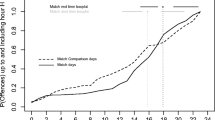Abstract
This paper explores the characteristics of local drugs markets through the examination of a single London borough case study. The picture that emerges in a borough not known for having a ‘drugs problem’ is of an entrenched, thriving and widespread drugs economy. Crucially, it is embedded within the local communities. Most worryingly, crack cocaine is being dealt in 15 out of 16 wards, with the front-line dealing predominantly carried out by youths as young as 15. Indeed, there are signs that the market has reached saturation point, while law enforcement merely scratches the surface. These findings reinforce the view that studies of organised crime must be sensitive to the local impacts of global markets, and that public policy debates about the responses to illegal drugs markets must be renewed and refreshed.
Similar content being viewed by others
Notes
The Metropolitan Police only established a London-wide intelligence capacity examining illegal drugs in late-2007, within the then-recently-formed Metropolitan Police Intelligence Bureau (MIB).
The source for the borough ‘adult drug treatment plan 2007/08’ will not be given to protect the anonymity of the borough. Nevertheless, these plans for all London boroughs can be found at: http://www.nta.nhs.uk/areas/treatment_planning/treatment_plans_2007_08/trpl1_07_08_london_se_sw.aspx
The MPA reports that in response to enquiries for its Drugs Scrutiny it was told that ‘drugs could be found in every ward of every borough’ in London (MPA 2007: 21).
Interestingly, the Drugs Squad respondents reported a rather different type of business model operating elsewhere in the borough, with users being ‘stacked’—that is, congregated in one place—with a large number of deals then taking place at the same time. It was suggested that this tactic was used to minimise exposure to public scrutiny and police surveillance, although one consequence was members of the public noticing groups of users hanging around.
It should be noted that a typical ‘crack house’ is simply a property being used for drug dealing and use. This contrasts with earlier manifestations of ‘crack houses’, which were often heavily fortified properties from which drugs were dealt, to be consumed elsewhere.
Illustrating the potential size of this market at the regional level, a different London borough has over 1,000 hostel residents living there at any one time.
The link between the ‘local’ (pub) and drug use in the borough in question has previously been documented in ethnographic research that discussed the ‘normalised’ use of cannabis and (increasingly) powder cocaine amongst several overlapping groups of largely white working class pub-goers (Pearson 2001).
The true number of professional football clubs is not being given to protect the anonymity of the case study borough.
Notable exceptions in London include Camden Town and Brixton, where cannabis is dealt openly to passers-by.
It is worth noting that the MPS did nevertheless record nine offences of cannabis production in the case study borough between April 2005 and March 2007 (see Table 1).
Although the reasons for this apparent absence of cannabis cultivation were not explored, it seems likely that this reflects some combination of (a) relatively high housing costs in, and (b) the ethnic composition of, the borough under examination.
References
Cragg Ross Dawson (2003) Crack cocaine in London: qualitative research focussing on Brent, Camden, Lambeth and Westminster. Cragg Ross Dawson, London
Department for Communities and Local Government (DCLG) (2007) Indices of deprivation 2007: local authority summaries. Department for Communities and Local Government, London http://www.communities.gov.uk/documents/communities/xls/576504
Duffy M, Schafer N, Coomber R, O’Connell L, Turnbull PJ (2008) Cannabis supply and young people: ‘it’s a social thing’. Joseph Rowntree Foundation, York
Hales G (2005) Gun crime in Brent. University of Portsmouth, Portsmouth http://www.port.ac.uk/departments/academic/icjs/staff/documentation/filetodownload,58106,en.pdf
Hales G, Lewis C, Silverstone D (2006) Gun crime: the market in and use of illegal firearms. Home Office Research Study 298. Home Office, London
Hay G, Gannon M, MacDougall J, Millar T, Eastwood C, McKeganey N (2007) Local and national estimates of the prevalence of opiate use and/or crack cocaine use 2005/06: a summary of key findings. Home Office Online Report 21/07. Home Office, London www.homeoffice.gov.uk/rds/pdfs07/rdsolr2107.pdf
Matrix Knowledge Group (2007) The illicit drug trade in the United Kingdom, 2nd edn. Home Office online report 20/07. Home Office, London www.homeoffice.gov.uk/rds/pdfs07/rdsolr2007.pdf
Metropolitan Police (2009) Crime mapping: data tables. Metropolitan Police, London http://maps.met.police.uk/tables.htm
Metropolitan Police Authority (2007) Drugs scrutiny report 2007 (Version 11). MPA, London http://www.mpa.gov.uk/downloads/committees/mpa/070531-6a-appendix01.pdf
Pearson G (2001) Normal drug use: ethnographic fieldwork among an adult network of recreational drug users in Inner London. Substance Use and Misuse 36(1&2):167–200
Penfold C, Turnbull PJ, Webster R (2005) Tackling prison drug markets: an exploratory qualitative study. Home Office Online Report 39/05. Home Office, London http://www.homeoffice.gov.uk/rds/pdfs05/rdsolr3905.pdf
Author information
Authors and Affiliations
Corresponding author
Additional information
Gavin Hales is an Independent researcher
Rights and permissions
About this article
Cite this article
Hales, G., Hobbs, D. Drug markets in the community: a London borough case study. Trends Organ Crim 13, 13–30 (2010). https://doi.org/10.1007/s12117-009-9086-9
Published:
Issue Date:
DOI: https://doi.org/10.1007/s12117-009-9086-9




